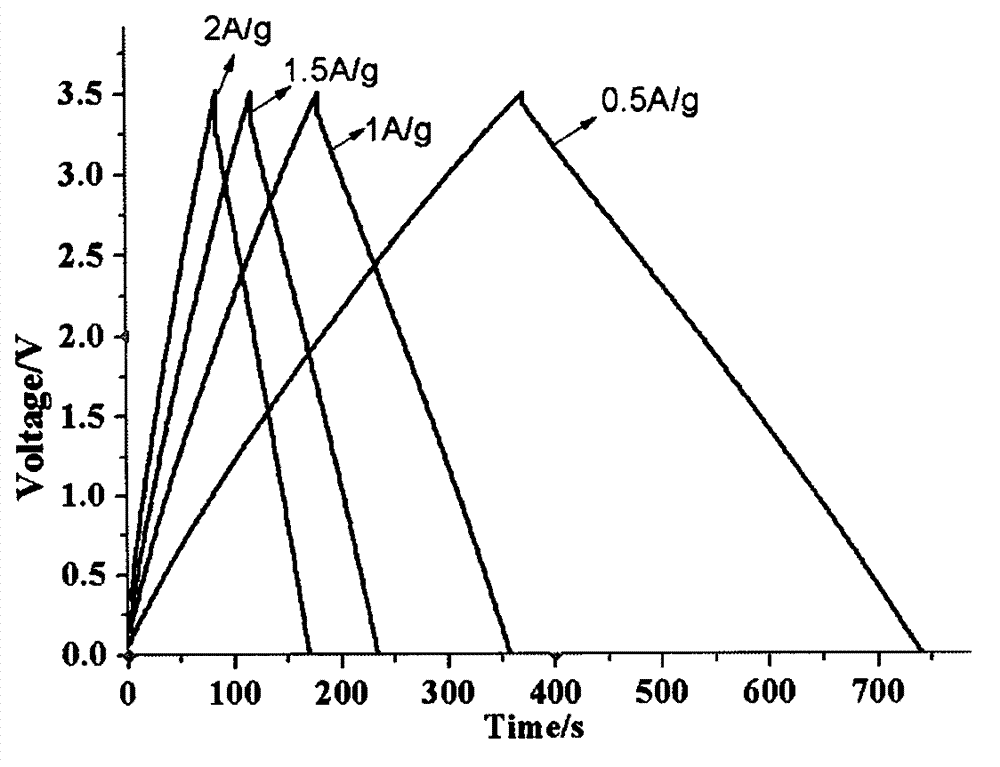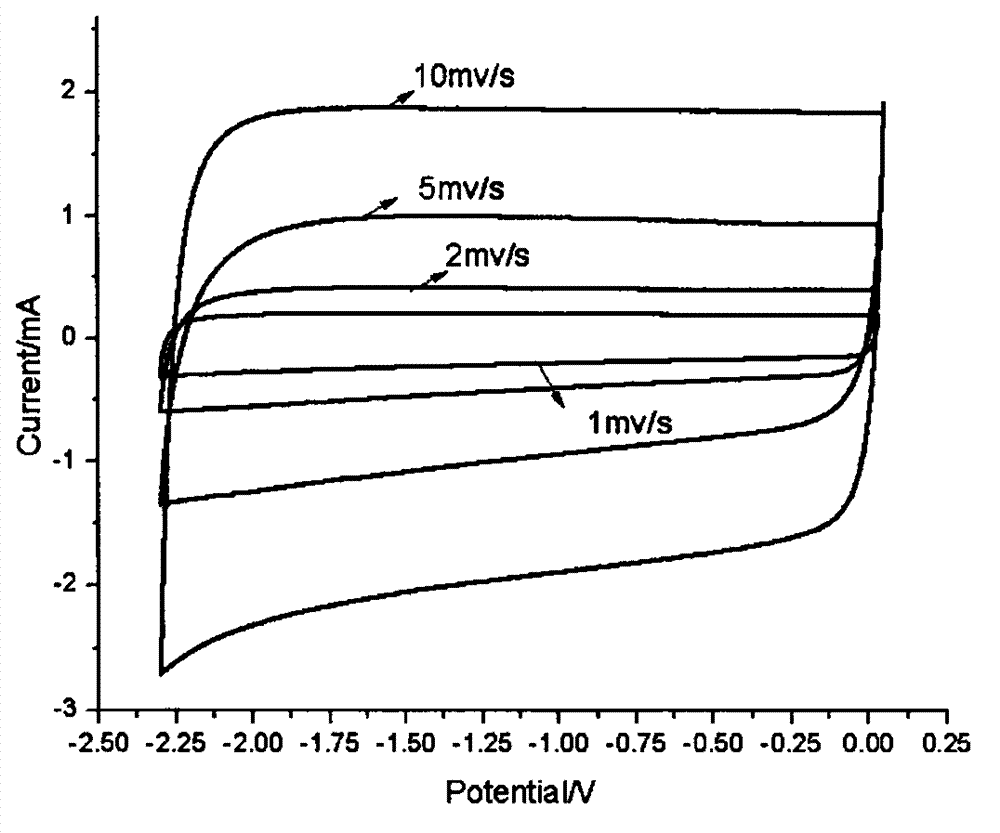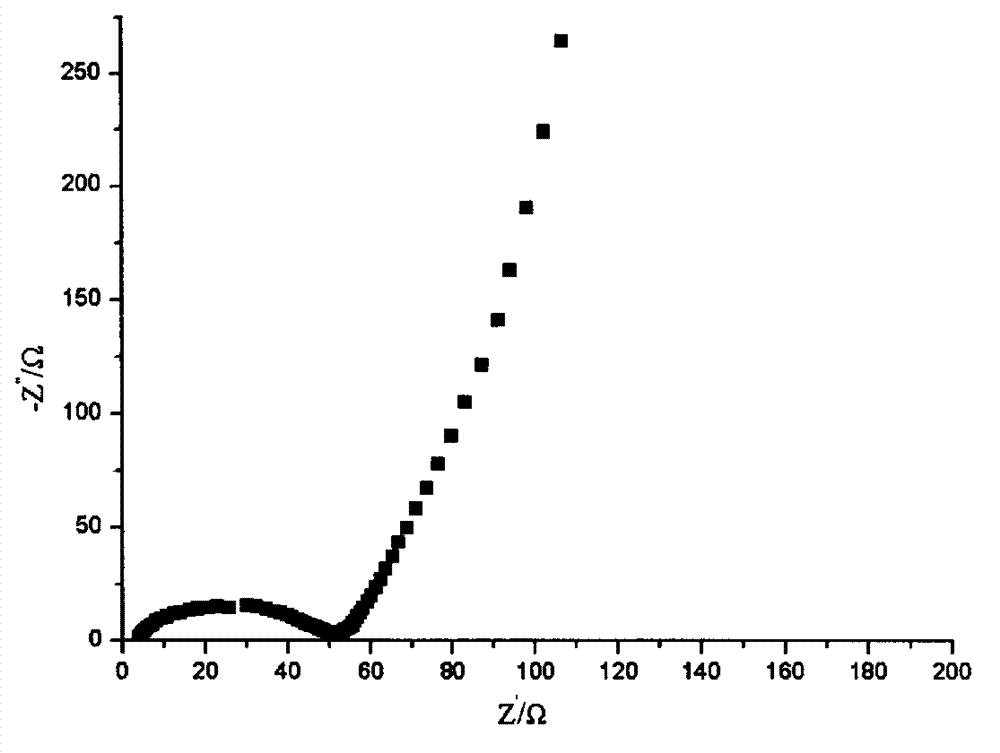Method for manufacturing electrode material of supercapacitor by cotton-stalk-based active carbon material
A technology for supercapacitors and electrode materials, applied in the field of electrochemistry, can solve problems such as low power density, long charging time, and preparation of activated carbon materials for supercapacitors
- Summary
- Abstract
- Description
- Claims
- Application Information
AI Technical Summary
Problems solved by technology
Method used
Image
Examples
Embodiment 1
[0024] a. Cotton stalks are peeled, crushed, and sieved to 80 mesh to obtain granules;
[0025] b. drying the pulverized cotton stalk particles at a temperature of 80°C;
[0026] c. Mix the dried cotton stalk particles with activator H 3 PO 4 Mix and impregnate at a mass ratio of 1:4 for 12 hours;
[0027] d. drying the impregnated cotton stalk particles at a temperature of 80° C. to obtain a mixture;
[0028] e. Under the protection condition of inert gas argon, the mixture obtained in step d is raised to a temperature of 700° C. at a heating rate of 2° C. / min, and activated at a constant temperature for 2 hours. The activation reaction temperature is 700°C, the activation reaction time is 2h, and the activated carbon material is obtained;
[0029] f. The activated carbon material obtained in step e is cooled to room temperature with the furnace, taken out, washed to neutrality, and then dried at a temperature of 100°C to obtain the supercapacitor electrode material.
Embodiment 2
[0031] a. Cotton stalks are peeled, crushed, and sieved to 100 mesh to obtain granules;
[0032] b. drying the pulverized cotton stalk particles at a temperature of 80°C;
[0033] c. Mix the dried cotton stalk particles with the activator CaCl 2 Mix and impregnate for 5 hours according to the mass ratio of 1:3;
[0034] d. drying the impregnated cotton stalk particles at a temperature of 80° C. to obtain a mixture;
[0035] e. Under the protection of inert gas nitrogen, the mixture obtained in step d is raised to a temperature of 900° C. at a heating rate of 5° C. / min, and activated at a constant temperature for 3 hours. The activation reaction temperature is 900° C., and the activation reaction time is 3 hours. Activated carbon material;
[0036] f. The activated carbon material obtained in step e is cooled to room temperature with the furnace, taken out, washed to neutrality, and then dried at a temperature of 100°C to obtain the supercapacitor electrode material.
Embodiment 3
[0038] a. Cotton stalks are peeled, crushed, and sieved to 120 mesh to obtain granules;
[0039] b. drying the pulverized cotton stalk particles at a temperature of 80°C;
[0040] c. Mix and impregnate the dried cotton stalk particles with the activator NaOH at a mass ratio of 1:2 for 7 hours;
[0041] d. drying the impregnated cotton stalk particles at a temperature of 80° C. to obtain a mixture;
[0042] e. The vacuum degree under vacuum conditions is 133.322×10 -3 -133.322×10 -5 Under the condition of Pa, the mixture obtained in step d is raised to a temperature of 600° C. at a heating rate of 3° C. / min, and activated at a constant temperature of 2.5 hours. The activated reaction temperature is 600° C., and the activation reaction time is 2.5 hours to obtain an activated carbon material;
[0043] f. The activated carbon material obtained in step e is cooled to room temperature with the furnace, taken out, washed to neutrality, and then dried at a temperature of 100°C to ...
PUM
 Login to View More
Login to View More Abstract
Description
Claims
Application Information
 Login to View More
Login to View More - R&D
- Intellectual Property
- Life Sciences
- Materials
- Tech Scout
- Unparalleled Data Quality
- Higher Quality Content
- 60% Fewer Hallucinations
Browse by: Latest US Patents, China's latest patents, Technical Efficacy Thesaurus, Application Domain, Technology Topic, Popular Technical Reports.
© 2025 PatSnap. All rights reserved.Legal|Privacy policy|Modern Slavery Act Transparency Statement|Sitemap|About US| Contact US: help@patsnap.com



